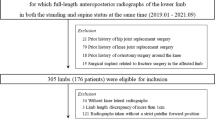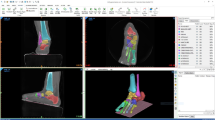Abstract
Purpose
We identified limb misalignment by applying personalized axial force while the limb was in a supine position to mimic a standing posture. This study aimed to confirm the accuracy of evaluating lower limb alignment using supine weight-bearing CT scanograms.
Methods
We prospectively compared measurements of the weight-bearing line ratio (WBL), hip-knee-ankle (HKA) angle, and joint convergence angle (JLCA) in 46 sets of supine weight-bearing CT scanograms with those obtained from full-length standing anteroposterior lower extremity radiographs. We achieved the weight-bearing CT scanograms by applying six different levels of axial force: zero, 1/5 of body weight, 2/5 of body weight, 3/5 of body weight, 4/5 of body weight, and full body weight. We assessed the impact of age, body mass index, HKA, and JLCA on the observed mechanical axis deviation differences between the two methods.
Result
The average absolute difference between standing radiographs and supine CT scanograms was 4.32% for the WBL ratio (p < 0.05), 1.25° for HKA (p < 0.05), and 0.46 for JLCA (p < 0.05). The mean absolute difference was minimal when applying full body weight axial pressure during CT scanograms (p > 0.05). Age, body mass index, HKA, and JLCA had no effect on the deviation in the mechanical axis measurements obtained through supine weight-bearing CT scanograms with full body weight.
Conclusion
No significant differences were found in assessing lower limb alignment between standing radiographs and supine weight-bearing CT scanograms with full body weight. Weight-bearing CT scanograms prove to be a valuable method for assessing lower limb alignment while in a supine position.




Similar content being viewed by others
Data Availability
The data that support the findings of this study are available from the corresponding author, [Chen Zhao], upon reasonable request.
References
Sharma L, Song J, Felson DT, Cahue S, Shamiyeh E, Dunlop DD. The role of knee alignment in disease progression and functional decline in knee osteoarthritis. JAMA. 2001;286(2):188–95.
Bäthis H, Perlick L, Tingart M, Lüring C, Zurakowski D, Grifka J. Alignment in total knee arthroplasty. A comparison of computer-assisted surgery with the conventional technique. J Bone Joint Surg Br. 2004;86(5):682–7.
Andriacchi TP. Dynamics of knee malalignment. Orthop Clin North Am. 1994;25(3):395–403.
Paley D. Principles of deformity correction. 1st ed. Springer Berlin; 2002.
Sabharwal S, Zhao C, McKeon JJ, McClemens E, Edgar M, Behrens F. Computed radiographic measurement of limb-length discrepancy. Full-length standing anter oposterior radiograph compared with scanogram. J Bone Joint Surg Am. 2006;88(10):2243–51.
Bathis H, Perlick L, Tingart M, Luring C, Zurakowski D, Grifka J. Alignment in total knee arthroplasty A comparison of computer-assisted surgery with the con ventional technique. J Bone Joint Surg Br. 2004;86(5):682–7.
Hankemeier S, Hufner T, Wang G, Kendoff D, Zheng G, Richter M, Gosling T, Nolte L, Krettek C. Navigated intraoperative analysis of lower limb alignment. Arch Orthop Trauma Surg. 2005;125(8):531–5.
Keene G, Simpson D, Kalairajah Y. Limb alignment in computer-assisted minimally-invasive unicompartmental knee replacement. J Bone Joint Surg Br. 2006;88(1):44–8.
Paternostre F, Schwab PE, Thienpont E. The difference between weight-bearing and non-weight-bearing alignment in patient-specific instrumentation planning. Knee Surg Sports Traumatol Arthrosc. 2014;22(3):674–9.
Gbejuade HO, White P, Hassaballa M, Porteous AJ, Robinson JR, Murray JR. Do long leg supine CT scanograms correlate with weight-bearing full-length radiographs to measure lower limb coronal alignment? Knee. 2014;21(2):549–52.
Sabharwal S, Zhao C. Assessment of lower limb alignment: supine fluoroscopy compared with a standing full-length radiograph. J Bone Joint Surg Am. 2008;90(1):43–51.
Orina JN, Berven SH. Principles of deformity correction. Berlin Heidelberg: Springer; 2017.
Rauh MA, Boyle J, Mihalko WM, Phillips MJ, Bayers-Thering M, Krackow KA. Reliability of measuring long-standing lower extremity radiographs. Orthopedics. 2007;30(4):299–303.
Swanson KE, Stocks GW, Warren PD, Hazel MR, Janssen HF. Does axial limb rotation affect the alignment measurements in deformed limbs? Clin Orthop Relat Res. 2000;371:246–52.
Howell SM, Kuznik K, Hull ML, Siston RA. Longitudinal shapes of the tibia and femur are unrelated and variable. Clin Orthop Relat Res. 2010;468(4):1142–8.
Van Raaij TM, Brouwer RW, Reijman M, Bierma-Zeinstra SM, Verhaar JA. Conventional knee films hamper accurate knee alignment determination in patients with varus osteoarthritis of the knee. Knee. 2009;16(2):109–11.
Funding
This work was supported by the Ethics Committee of Scientific research program of Shaanxi Provincial Department of Education (21JK0892) and the Research project of the Second Affiliated Hospital of Xi’an Medical College (20KY0101).
Author information
Authors and Affiliations
Corresponding author
Ethics declarations
Consent to participate
Informed consent for the use of medical data was obtained from all patients.
Consent for publication
Not applicable.
Conflict of interest
The authors declare competing interests.
Additional information
Publisher's Note
Springer Nature remains neutral with regard to jurisdictional claims in published maps and institutional affiliations.
Supplementary information
Below is the link to the electronic supplementary material.
Rights and permissions
Springer Nature or its licensor (e.g. a society or other partner) holds exclusive rights to this article under a publishing agreement with the author(s) or other rightsholder(s); author self-archiving of the accepted manuscript version of this article is solely governed by the terms of such publishing agreement and applicable law.
About this article
Cite this article
Liu, X., Zhang, B., Zhao, C. et al. Assessment of lower limb alignment: supine weight-bearing CT scanograms compared with a standing full-length radiograph. Skeletal Radiol (2024). https://doi.org/10.1007/s00256-024-04637-z
Received:
Revised:
Accepted:
Published:
DOI: https://doi.org/10.1007/s00256-024-04637-z




